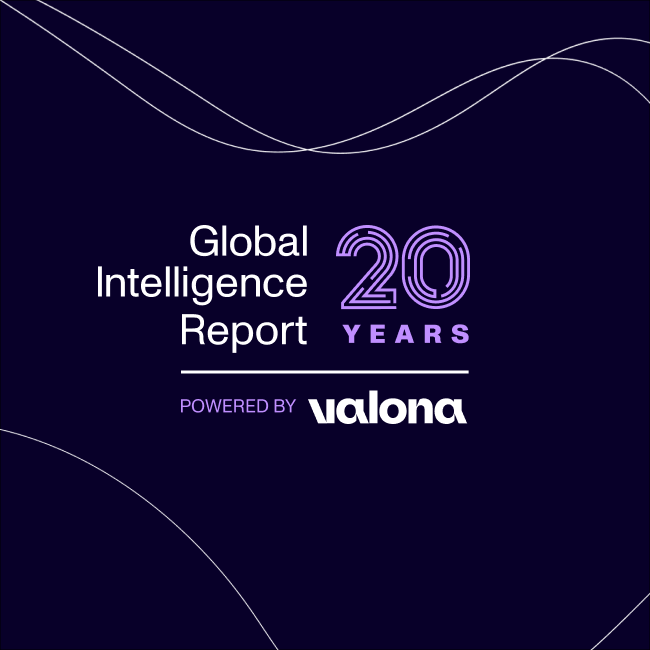
Trend analysis: A key to effective strategic foresight
Learn how trend analysis helps businesses stay ahead by spotting patterns, anticipating shifts, and driving innovation. Master methods to seize opportunities and future-proof strategies.
Trends don’t just happen—they leave clues. Trend analysis is the art of piecing together those clues to reveal patterns, shifts, and opportunities waiting to be seized. Whether it’s understanding emerging technologies, evolving markets, or changing customer needs, this approach empowers you to navigate uncertainty like a pro.
A cornerstone of strategic foresight, it transforms data into a roadmap for action. While the sea of tools and techniques might seem overwhelming at first, learning to decode trends effectively unlocks smarter choices and sustainable success.
This article explains the methods and best practices for conducting trend analysis effectively:
- Defining objectives and scope
- Collecting diverse data sources
- Analyzing patterns and correlations
- Categorizing trends
- Using visualization tools
- Validating findings with experts
Understanding trend analysis: a proactive tool for business success
Trend analysis plays a vital role in helping businesses navigate an ever-changing landscape. By identifying patterns and shifts in data over time, this method offers insights into emerging opportunities and potential challenges. Unlike reactive approaches, trend analysis equips organizations with a proactive framework for smarter decision-making.
“Trend analysis empowers organizations to predict change, adapt with confidence, and thrive in dynamic markets.”
This process focuses on understanding long-term patterns in areas like technology, consumer behavior, and market dynamics. For instance, identifying a gradual rise in demand for sustainable products enables businesses to adapt their strategies ahead of competitors.
Strategically, trend analysis is a cornerstone of future-ready planning. It enables businesses to:
- Anticipate changes: Spotting shifts in customer preferences or technological advancements ensures you stay ahead of industry trends.
- Mitigate risks: By recognizing early warning signals, businesses can adjust their plans before disruptions occur.
- Identify growth opportunities: Analyzing trends uncovers untapped markets and informs product innovation.
Trend analysis isn’t just about looking at numbers—it’s about seeing the bigger picture and preparing for what’s next. When done effectively, it transforms data into actionable insights, keeping businesses agile and competitive.
Why is trend analysis important in strategic foresight?
Trend analysis is a cornerstone of strategic foresight, empowering businesses to make decisions that align with future possibilities.
By analyzing patterns and shifts over time, organizations gain the ability to anticipate change, adjust proactively, and remain resilient in dynamic markets.
Making data-driven decisions is one of the most significant benefits of trend analysis. By relying on clear, actionable insights instead of guesswork, businesses can craft strategies that align with market demands and future possibilities.
For example, tracking advancements in AI adoption could guide investments in automation, ensuring alignment with industry progression.
“Trend analysis bridges the gap between today’s decisions and tomorrow’s challenges, enabling businesses to thrive in an ever-changing world.”
Identifying emerging opportunities is another critical advantage. Trend analysis reveals potential growth areas, such as a rising demand for eco-friendly products or an increase in remote work solutions. These insights enable businesses to innovate ahead of competitors and capture new market segments.
Mitigating risks becomes more manageable when organizations understand long-term trends. Recognizing signals of potential disruptions—like changes in consumer behavior or regulatory landscapes—allows companies to adapt and reduce vulnerabilities before challenges escalate.
Additionally, supporting innovation is a natural outcome of trend analysis. By observing patterns in technology or societal shifts, businesses can develop cutting-edge products and services that cater to evolving needs, keeping them competitive in fast-paced industries.
Want to turn trend analysis into a competitive advantage? Try Valona’s trend radars! Our market intelligence solution delivers real-time insights into emerging patterns, market shifts, and customer behavior. Identify opportunities, anticipate challenges, and stay ahead of the curve.
Best practices for conducting effective trend analysis
1: Define objectives and scope
Defining objectives and scope is the first step to effective trend analysis. Clear objectives help you focus your efforts and gather relevant insights that lead to actionable results. Without defined goals, it’s easy to get overwhelmed by the volume of data and miss key trends.
Trend analysis can cover various areas like consumer behavior, industry shifts, or technological advancements. For instance, if you want to understand customer preferences, prioritize data on purchasing habits and feedback. If your focus is on regulatory changes, analyze government policies and compliance trends to stay ahead.
To define your scope effectively:
- Set clear goals: Decide what you want to achieve—be it identifying opportunities, mitigating risks, or optimizing processes.
- Choose key focus areas: Determine whether you’re analyzing customer behavior, technological advances, or competitive dynamics
- Ensure alignment: Confirm that your objectives align with your business’s long-term goals and immediate priorities.
- Break down goals into smaller tasks: This makes it easier to tackle complex areas and ensures steady progress.
A well-defined scope ensures your analysis remains targeted and practical, helping you uncover trends that truly matter to your organization. You can save time and resources by staying focused and ensuring better results.
2: Collect diverse data sources
Collecting diverse data sources strengthens trend analysis by offering a well-rounded perspective. Using multiple streams of information helps capture both quantitative data, like numbers and metrics, and qualitative insights, like opinions and emotions. This balanced approach ensures a clearer understanding of trends and their implications.
For example, industry reports and market research reveal big-picture trends, while social media and customer feedback provide real-time updates on shifting preferences. Combining these sources can uncover hidden opportunities or detect changes before they fully emerge.
To effectively diversify your data sources:
- Leverage reports and studies: Use white papers, market surveys, and industry publications to gain deep insights into broader trends.
- Explore online platforms: Monitor discussions on social media and forums for emerging topics and real-time sentiment.
- Blend data types: Combine metrics like sales trends or website traffic with qualitative data like customer reviews or focus group findings.
- Include global and local insights: Gather data from international markets and local communities for a complete view of trends at all levels.
A diverse range of data sources ensures your trend analysis is thorough and unbiased, capturing the full scope of relevant signals. It also increases the accuracy of your findings, empowering your business to make confident and informed decisions.
3: Analyze patterns and correlations
Analyzing patterns and correlations transforms raw data into actionable insights. Spotting recurring themes helps businesses anticipate changes and stay ahead of trends before they become widespread. This step allows organizations to connect the dots between different data points, revealing emerging opportunities and potential challenges.
For instance, an increase in discussions about sustainable packaging might signal growing consumer demand for eco-friendly products. Recognizing this early enables businesses to adapt and capture market interest.
To analyze patterns effectively:
- Search for recurring themes: Review datasets for consistent behaviors, preferences, or trends that appear across different sources.
- Spot weak signals: Pay attention to subtle indicators of change, such as niche products gaining traction or shifts in customer sentiment.
- Identify correlations: Look for relationships between trends, like how rising social consciousness affects purchasing decisions or how economic conditions influence customer loyalty.
- Track long-term patterns: Monitor changes over time to understand whether a trend is temporary or a long-term shift in the market.
Pattern analysis provides clarity on key drivers of change, equipping businesses to make strategic decisions. It turns data into foresight, allowing organizations to act proactively and align their strategies with future opportunities.
4: Categorize trends
Categorizing trends helps businesses prioritize their efforts by classifying insights into short-term, long-term, and emerging trends. This step ensures you allocate resources effectively and balance immediate needs with future planning. By organizing trends this way, companies can act quickly on pressing demands while positioning themselves for lasting success.
For instance, a short-term trend might involve seasonal shopping habits, requiring adjustments in marketing or inventory. Long-term trends, like the rise of automation, demand strategic investments in technology and training. Emerging trends, such as early interest in a new social media platform, offer opportunities to innovate and lead the market.
To categorize trends effectively:
- Short-term trends: Pinpoint immediate actions, such as promotional campaigns or adapting to sudden market changes.
- Long-term trends: Focus on structural shifts in your industry, like changing consumer values or regulatory requirements.
- Emerging trends: Monitor early-stage developments, such as niche products or new technologies gaining traction.
Categorizing trends allows businesses to approach each opportunity with clarity and purpose. It ensures you address urgent needs without losing sight of long-term goals and keeps you prepared for growth and transformation.
5: Use visualization tools
Visualization tools transform complex trend data into clear, actionable insights. By presenting information through charts, graphs, or dashboards, businesses can simplify analysis and ensure stakeholders understand key trends. Visuals make it easier to align strategies with market shifts and drive informed decisions.
For instance, a trend map might illustrate how customer preferences evolve, revealing opportunities to refine product offerings or marketing approaches. This clarity ensures teams can act on insights swiftly and with confidence.
Best practices for using visualization tools:
- Choose the right platform: Leverage tools like Tableau, Google Data Studio, or Power BI to create engaging and interactive dashboards.
- Focus on key takeaways: Highlight the most critical trends and insights, avoiding clutter or unnecessary complexity.
- Incorporate storytelling: Use visuals to craft a narrative that explains trends and their implications for your business.
- Engage stakeholders: Share visuals in meetings or reports to foster collaboration and ensure alignment on strategic priorities.
Visualization tools enhance trend analysis by making data accessible and actionable. They turn raw numbers into compelling stories, empowering businesses to communicate insights effectively and drive impactful decisions.
6: Validate findings with experts
Validating findings with experts ensures your trend analysis is both accurate and actionable. Expert opinions add depth and context, helping refine assumptions and confirm conclusions. This process strengthens the reliability of your insights and enhances decision-making.
For example, discussing a new technology trend with an industry specialist might uncover hidden risks or identify untapped opportunities your analysis missed. Internal teams, like marketing or R&D, can also offer valuable input based on their expertise.
Steps for validation:
- Engage external experts: Consult industry specialists or analysts who have extensive knowledge of your focus area.
- Collaborate with internal teams: Involve departments like product development or strategy to cross-check trends against their on-ground experiences.
- Refine findings: Incorporate expert feedback to adjust your conclusions, ensuring they’re aligned with real-world contexts.
- Test assumptions: Challenge your interpretations with expert input to validate their feasibility and impact.
Validation adds a layer of credibility to your trend analysis, ensuring it withstands scrutiny and effectively guides your strategic initiatives. By leveraging expertise, you build confidence in your findings and set the stage for more informed and successful decisions.
Harness the power of trend analysis
Trend analysis isn’t just about spotting patterns—it’s a powerful strategy for navigating uncertainty and driving innovation. By using proven techniques like categorizing trends, validating findings, and leveraging visualization tools, businesses can stay proactive and aligned with evolving market dynamics.
The effectiveness of your trend analysis depends on how well you gather, interpret, and act on insights. By refining your approach and focusing on actionable trends, you can unlock new opportunities, mitigate risks, and future-proof your strategies.
If you’re ready to dive deeper into how to identify emerging trends, uncover opportunities, and craft winning strategies, don’t miss Valona’s on-demand webinar: Master Competition with Strategic Foresight. Packed with actionable insights and expert guidance, it’s your go-to resource for turning analysis into advantage.
FAQ
What is trend analysis, and why is it important for businesses?
Trend analysis involves studying patterns and changes in data over time to predict future developments. It’s crucial for businesses as it helps anticipate market shifts, adapt strategies, and identify new opportunities. By understanding trends, companies can make proactive decisions, avoid risks, and stay competitive in evolving industries.
What are the main steps involved in conducting trend analysis?
Trend analysis includes defining objectives, collecting diverse data sources, analyzing patterns, categorizing trends, and validating findings. These steps ensure a thorough understanding of market dynamics and provide actionable insights for strategic planning. Using visualization tools like dashboards or trend maps can further enhance clarity and stakeholder communication.
How does trend analysis support innovation in businesses?
Trend analysis uncovers emerging opportunities by identifying shifts in consumer behavior, technology, and industry dynamics. This foresight inspires creative solutions and innovation, enabling businesses to develop new products or services that align with market needs. For example, spotting a rise in sustainability demands can drive eco-friendly product development.
What are the best tools for effective trend analysis?
Effective tools for trend analysis include Tableau, Google Data Studio, and market research platforms. These tools help visualize data, track industry shifts, and uncover actionable insights. Social listening platforms can also provide real-time feedback, while expert consultations refine findings for more accurate decision-making.
How can businesses ensure the accuracy of their trend analysis findings?
Accuracy in trend analysis comes from validating findings with experts, combining diverse data sources, and cross-checking insights with internal teams. Engaging specialists ensures well-rounded perspectives, while tools like data visualization enhance clarity. This approach strengthens the credibility of trend insights, making them actionable and reliable for decision-making.




